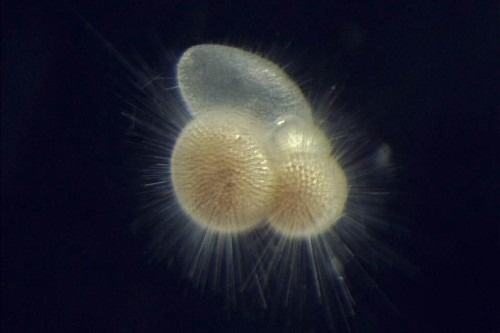At the Early Eocene Climatic Optimum, a period of persistently high global temperatures comparable to the worst-case scenarios of global warming, all marine plankton except the most specialized species migrated to higher latitudes.
 Trilobus. Image Credit: Tracy Aze
Trilobus. Image Credit: Tracy Aze
After comparing biodiversity and global community structure, the team - which included researchers from the University of Victoria, Harvard University, the University of Texas Institute for Geophysics, and the University of Bristol - discovered that the community frequently adapts to climate change millions of years before biodiversity declines.
According to the study, which was published in Nature, only the most specialized species of plankton survived the tropical heat as they moved to colder regions.
These results suggest that community-scale changes will become apparent well in advance of modern-day extinctions and underscore the need for increased effort in monitoring marine community structure to potentially anticipate future marine extinctions.
Considering three billion people live in the tropics, this is not great news. We knew that biodiversity amongst marine plankton groups has changed throughout the last 66 million years, but no one had ever explored it on a global, spatial, scale through the lens of a single database. We used the Triton dataset, that I created during my PhD, which offered new insights into how biodiversity responds spatially to global changes in climate, especially during intervals of global warmth which are relevant to future warming projections.”
Dr. Adam Woodhouse, Ecologist, School of Earth Sciences, University of Bristol
Together with Dr. Anshuman Swain, an expert in applying networks to biological data and an Ecologist, Dr. Woodhouse formed a team. Building on earlier studies on how cooling reorganized global marine plankton communities, they used networks to apply micropalaeontology for the first time to record the global spatial changes in community structure as climate progressed over the Cenozoic.
The fossil record of marine plankton is the most complete and extensive archive of ancient biological changes available to science. By applying advanced computational analyses to this archive we were able to detail global community structure of the oceans since the death of the dinosaurs, revealing that community change often precedes the extinction of organisms. This exciting result suggests that monitoring of ocean community structure may represent an ‘early warning system’ which precedes the extinction of oceanic life.”
Dr. Adam Woodhouse, Ecologist, School of Earth Sciences, University of Bristol
The group now intends to use comparable techniques on other marine plankton groups. A deeper examination is necessary for the numerous other microfossil groups that play significant roles in marine food webs. Their goal is to employ new climate models to model future community structure based on the patterns they have seen in the past and present.
Source:
Journal reference:
Swain, A., et al. (2024) Biogeographic response of marine plankton to Cenozoic environmental changes. Nature. doi.org/10.1038/s41586-024-07337-9